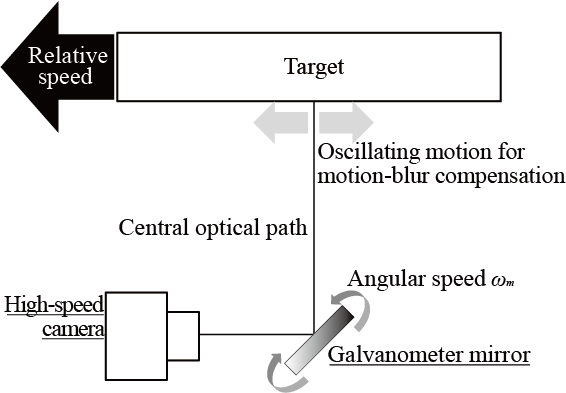Pixel-wise Deblurring Imaging(PDI)
Summary
Motion blurring occurs in imaging from a high-speed moving object. Therefore, in order to obtain a clear image, it is necessary to increase the shutter speed, and strong lighting is required under the same sensitivity condition. Therefore, for example, imaging for inspection of a tunnel wall surface of a highway necessitates regulation of tunnel traffic, which is an obstacle to frequent inspection. In order to eliminate this motion blur, we have proposed "Pixel-wise Deblurring Imaging(PDI)" which controls the optical axis of the imaging system at high speed with the same speed as the relative speed with the object from the image plane information alone. Improvement of the image quality of the captured image is confirmed.
 |
 |
 |
High-speed tracking of the target image is realized by using a uniaxial galvanometer mirror for angle control of the optical axis and developing a new tracking algorithm. As a result, we demonstrated that motion blur is improved especially in the high frequency band compared with the conventional method.
In the conventional method, the speed of the entire system is limited due to insufficient responsiveness of the galvanometer mirror, and even with the galvanometer mirror used in this research, initially, execution at 100 Hz was the limit, however, we propose a method to expand the frequency range that can follow highly precisely by using pre-emphasis technology and show that it can be executed with sufficient accuracy up to 500 Hz by experiment. As a result of applying this method to the motion blur compensation device, it was found that the removal performance of motion blur is improved by driving the galvano mirror at high frequencies.
References
- Tomohiko Hayakawa, Takanoshin Watanabe, Taku Senoo, and Masatoshi Ishikawa: Gain-compensated sinusoidal scanning of a galvanometer mirror in proportional-integral-differential control using the pre-emphasis technique for motion-blur compensation, Applied Optics, Vol. 55, Issue 21, pp. 5640-5646 (2016)
- Tomohiko Hayakawa, Takanoshin Watanabe, and Masatoshi Ishikawa: Real-time high-speed motion blur compensation system based on back-and-forth motion control of galvanometer mirror, Opt. Express, Vol.23, Issue 25, pp. 31648-31661 (2015).



